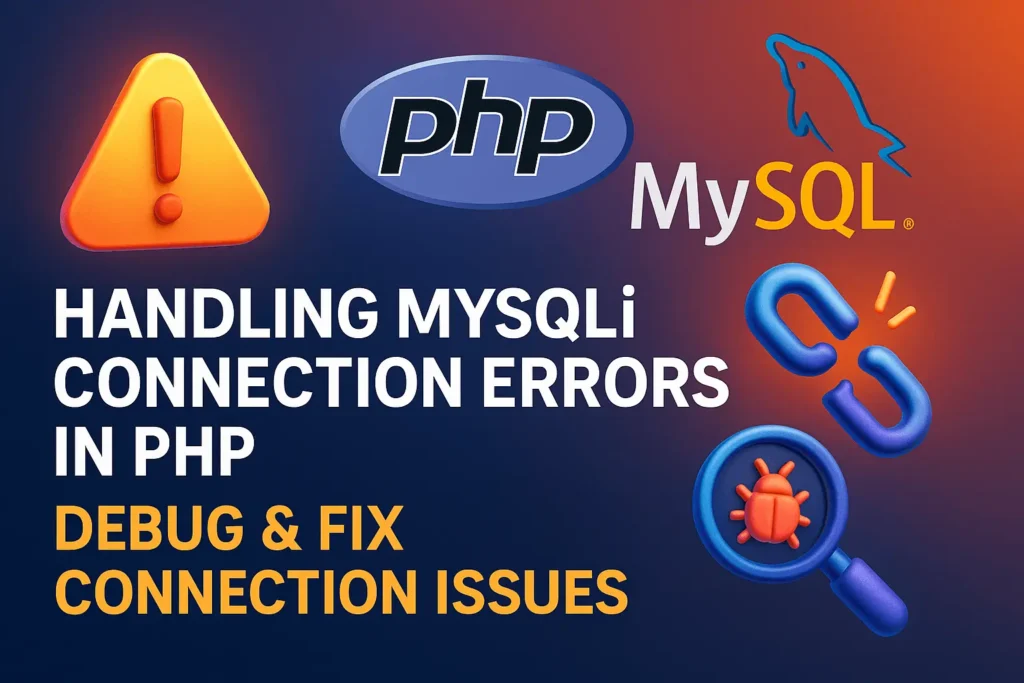Effective error handling in MySQLi (MySQL Improved) can help diagnose and resolve these issues, ensuring that your application remains stable and secure.
In this article, we will explore common MySQLi connection errors and their solutions. We will cover error handling techniques for both the object-oriented and procedural approaches, provide code examples, and discuss best practices for managing database connections.
Understanding MySQLi Error Handling
MySQLi offers built-in error handling mechanisms that allow developers to capture and respond to errors during the connection process. The primary methods and properties used for error handling in MySQLi include:
connect_error: Returns the error description from the last connection attempt.
connect_errno: Returns the error code from the last connection attempt.
mysqli_report(): Configures whether MySQLi will throw exceptions or just log errors.
Common Connection Errors and Their Solutions
1. Incorrect Database Credentials
One of the most common connection errors is using incorrect database credentials (hostname, username, password, or database name).
Symptoms
Warning: mysqli::__construct(): (HY000/1045): Access denied for user ‘username’@’localhost‘ (using password: YES)
Solution
Ensure that the database credentials in your configuration file are correct. Double-check the username, password, and database name. Here is an example of how to handle this in both object-oriented and procedural styles.
Object-Oriented Approach:
<?php
require_once 'config.php';
$mysqli = new mysqli(DB_SERVER, DB_USERNAME, DB_PASSWORD, DB_NAME);
if ($mysqli->connect_error) {
die("Connection failed: " . $mysqli->connect_error);
} else {
echo "Connected successfully";
}
?>
Procedural Approach:
<?php
require_once 'config.php';
$conn = mysqli_connect(DB_SERVER, DB_USERNAME, DB_PASSWORD, DB_NAME);
if ($conn === false) {
die("ERROR: Could not connect. " . mysqli_connect_error());
} else {
echo "Connected successfully";
}
?>
2. Hostname Issues
Incorrect or unreachable hostname can cause connection failures.
Symptoms
Warning: mysqli::__construct(): (HY000/2002): No such file or directory
Warning: mysqli::__construct(): (HY000/2002): Connection timed out
Solution
Verify that the hostname is correct and the MySQL server is running. If using localhost, try 127.0.0.1 instead to avoid socket issues.
Object-Oriented Approach:
<?php
require_once 'config.php';
$mysqli = new mysqli('127.0.0.1', DB_USERNAME, DB_PASSWORD, DB_NAME);
if ($mysqli->connect_error) {
die("Connection failed: " . $mysqli->connect_error);
} else {
echo "Connected successfully";
}
?>
Procedural Approach:
<?php
require_once 'config.php';
$conn = mysqli_connect('127.0.0.1', DB_USERNAME, DB_PASSWORD, DB_NAME);
if ($conn === false) {
die("ERROR: Could not connect. " . mysqli_connect_error());
} else {
echo "Connected successfully";
}
?>
3. Database Server Not Running
If the MySQL server is not running, you will encounter connection errors.
Symptoms
Warning: mysqli::__construct(): (HY000/2002): Can’t connect to MySQL server on ‘hostname’
Solution
Start the MySQL server and ensure it is running. On Unix-based systems, use:
sudo service mysql start
On Windows, start the MySQL service from the Services control panel or using the MySQL Workbench.
4. Exceeding the Maximum Number of Connections
MySQL servers limit the number of concurrent connections. Exceeding this limit can prevent new connections.
Symptoms
Warning: mysqli::__construct(): (HY000/1040): Too many connections
Solution
Increase the maximum number of allowed connections in the MySQL server configuration file (my.cnf or my.ini). Add or modify the following line under the [mysqld] section:
[mysqld]
max_connections = 500
Restart the MySQL server after making this change. Additionally, ensure your application closes database connections properly.
5. Unknown Database
If the specified database does not exist, you will encounter an error.
Symptoms
Warning: mysqli::__construct(): (HY000/1049): Unknown database ‘database_name’
Solution
Ensure the database name is correct and the database exists. Create the database if it does not exist:
CREATE DATABASE database_name;
6. Network Issues
Network-related issues can prevent successful connections to the MySQL server.
Symptoms
Warning: mysqli::__construct(): (HY000/2003): Can’t connect to MySQL server on ‘hostname’ (110)
Solution
Check network connectivity between the PHP server and the MySQL server. Ensure that the MySQL server is accessible and that firewall rules are not blocking the connection. Use tools like ping and telnet to diagnose network issues.
Enhanced Error Handling Techniques
Proper error handling involves more than just printing error messages. Here are some best practices for managing errors in a production environment.
Using Exceptions
You can configure MySQLi to throw exceptions on errors. This allows you to use try-catch blocks for more structured error handling.
<?php
require_once 'config.php';
mysqli_report(MYSQLI_REPORT_STRICT);
try {
$mysqli = new mysqli(DB_SERVER, DB_USERNAME, DB_PASSWORD, DB_NAME);
echo "Connected successfully";
} catch (mysqli_sql_exception $e) {
echo "Connection failed: " . $e->getMessage();
}
?>
Logging Errors
Instead of displaying errors to users, log them to a file for later analysis. This approach improves security and user experience.
<?php
require_once 'config.php';
mysqli_report(MYSQLI_REPORT_STRICT);
try {
$mysqli = new mysqli(DB_SERVER, DB_USERNAME, DB_PASSWORD, DB_NAME);
echo "Connected successfully";
} catch (mysqli_sql_exception $e) {
error_log("Connection error: " . $e->getMessage());
echo "Connection failed. Please try again later.";
}
?>
Graceful Degradation
If a connection error occurs, you can gracefully degrade the functionality by providing a user-friendly message or alternative options.
<?php
require_once 'config.php';
mysqli_report(MYSQLI_REPORT_STRICT);
try {
$mysqli = new mysqli(DB_SERVER, DB_USERNAME, DB_PASSWORD, DB_NAME);
echo "Connected successfully";
} catch (mysqli_sql_exception $e) {
error_log("Connection error: " . $e->getMessage());
echo "We're experiencing technical difficulties. Please try again later.";
// Optionally provide alternative options like offline content or contact information
}
?>
Conclusion
Handling MySQLi connection errors effectively is crucial for developing robust PHP applications. By understanding common connection errors and implementing proper error handling techniques, you can improve the reliability and security of your application. Always ensure to validate and secure your database credentials, handle exceptions gracefully, and log errors for further analysis. Following these best practices will help you maintain a stable connection to your MySQL database and provide a better user experience.






